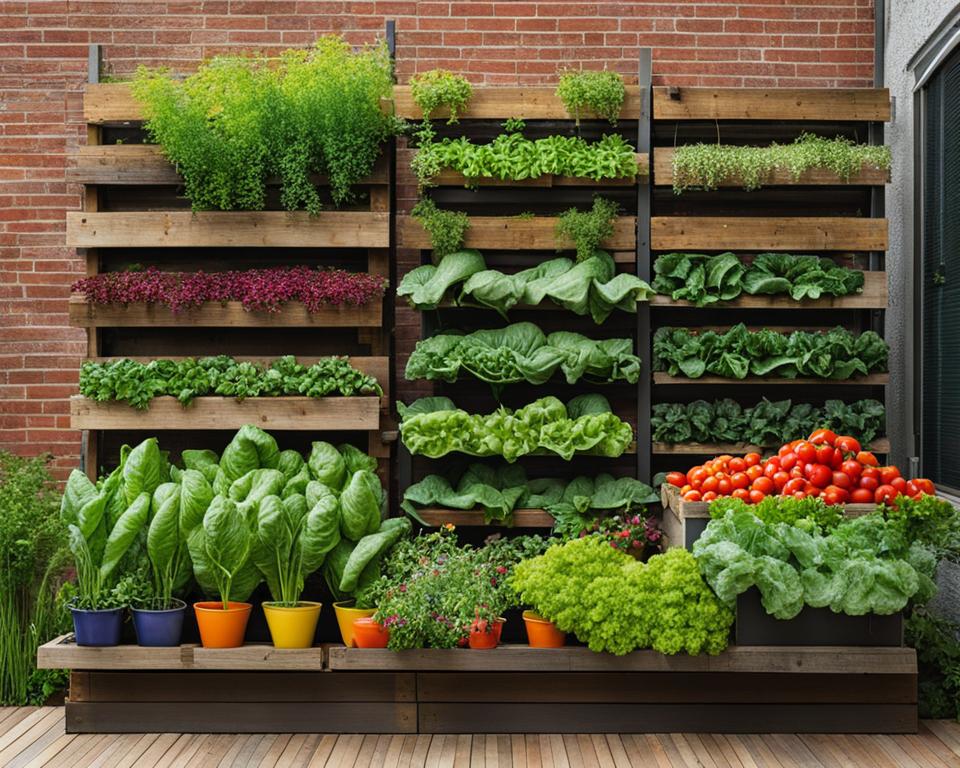Do you dream of growing your own vegetables but think it’s impossible due to limited space in your urban home? Think again! Vertical vegetable gardening offers a creative and practical solution tailored for city dwellers like you, who want to make the most out of their small urban spaces. By embracing the concept of vertical gardening, you can transform even the tiniest area into a green, productive, and visually stunning oasis. Read on to discover various creative vertical vegetable gardening ideas that will revolutionize the way you incorporate nature into your urban lifestyle.
Key Takeaways
- Vertical vegetable gardening is a space-saving solution for city dwellers to grow their own produce.
- It transforms small urban spaces into productive and visually appealing green areas.
- Choosing the right vegetables and designs is essential for a successful vertical garden.
- DIY projects and innovative structures make vertical gardening accessible to anyone.
- Proper care, watering, and maintenance are necessary to maintain a thriving vertical garden.
- Vertical gardens can enhance urban biodiversity and contribute to sustainable urban living.
The Rise of Urban Vertical Gardening
Urban vertical gardening has been rapidly gaining popularity in recent years as an innovative solution for sustainable urban living. Driven by the desire for self-sufficiency in food production and the limitations of small space vegetable gardening, it allows individuals to grow their own food in the most unlikely of places. In this era of growing urbanization, let’s explore the key factors responsible for this rising trend, and how it is transforming the concept of gardening in city landscapes.
One of the main reasons behind the rise of urban vertical gardening is the increasing space constraints in cities. With little room to spare, city dwellers are finding creative ways to utilize their limited outdoor spaces, rooftops, balconies, and even indoor areas. Vertical gardens enable them to grow vegetables, herbs, and fruits in a compact, space-efficient manner without having to compromise on the quality or quantity of their produce.
Urban vertical gardening is not just a necessity born out of space constraints, but also a local food movement driving sustainability and reducing carbon footprints.
Another significant factor fueling the rise of urban vertical gardening is the local food movement. People are becoming more conscious about the source of their food and are keen to consume fresh, organic produce while reducing their dependence on long-distance supply chains. By growing their own vegetables and herbs, urban gardeners can ensure that their food is free of pesticides and contributes positively to their overall health and well-being.
Lastly, the environmental benefits of urban gardening are undeniable. Vertical gardens help in improving air quality by absorbing pollutants and releasing oxygen, providing shade and reducing the heat island effect, and retaining stormwater runoff. They also support urban biodiversity, encouraging pollinators such as bees and butterflies to thrive in otherwise green-space deprived areas.
| Reasons for Growth | Consequences |
|---|---|
| Space Constraints | Efficiency in utilizing limited space to support vegetable growth |
| Local Food Movement | Access to fresh, organic produce reduces reliance on supply chains |
| Environmental Benefits | Enhanced air quality, heat reduction, stormwater retention, and urban biodiversity |
Thus, urban vertical gardening offers city dwellers numerous opportunities to live more sustainably and cultivate their own fresh produce despite living in the hustle and bustle of dense urban environments. Its rise reflects an inspiring shift towards sustainable urban living, empowering individuals to overcome the challenges of space-constrained city living and reconnect with nature. So, why not add some Vertical gardens to your life and join the urban gardening revolution?
Choosing the Right Vegetables for Your Vertical Garden
When embarking on your vertical vegetable gardening journey, it’s crucial to carefully select suitable vegetables that will thrive in a vertical setting. Factors like sunlight, water requirements, and vertical space play a significant role in determining the right plants for your garden. In this section, we will explore the ideal vegetables for vertical gardens, focusing on leafy greens, herbs, and dwarf varieties.
Leafy Greens and Herbs: Perfect for High Rise Edibles
Leafy greens and herbs are an excellent choice for vertical vegetable gardens due to their relatively low maintenance requirements and adaptability to high rise growing conditions. These plants typically require less sunlight and can be grown close together, making them ideal for compact urban spaces. Some popular leafy greens and herbs to consider for your vertical garden include:
- Spinach
- Kale
- Swiss chard
- Lettuce
- Basil
- Parsley
- Cilantro
These versatile plants can be incorporated into salads, side dishes, and even smoothies, providing you with an array of nutrient-rich ingredients grown right in your urban vertical garden.
Dwarf Varieties: Compact Plants for Small Spaces
For those with limited space, dwarf and bush varieties of vegetables are an excellent option. Bred specifically for their compact nature, these plants are tailor-made for small space gardens, including vertical setups. Here are some popular dwarf vegetable varieties to consider:
| Vegetable | Dwarf Variety |
|---|---|
| Tomato | Tiny Tim, Cherry Falls |
| Cucumber | Bush Champion, Spacemaster |
| Pepper | Mini Bell, Jingle Bells |
| Eggplant | Little Prince, Bambino |
| Zucchini | Black Forest, Astia |
These compact plants not only save space in your vertical garden but also typically require less maintenance compared to their full-sized counterparts. By selecting the proper leafy greens, herbs, and dwarf vegetable varieties, you’ll be well on your way to cultivating a successful vertical garden in your urban space.
Maximizing Space with Creative Vertical Structures
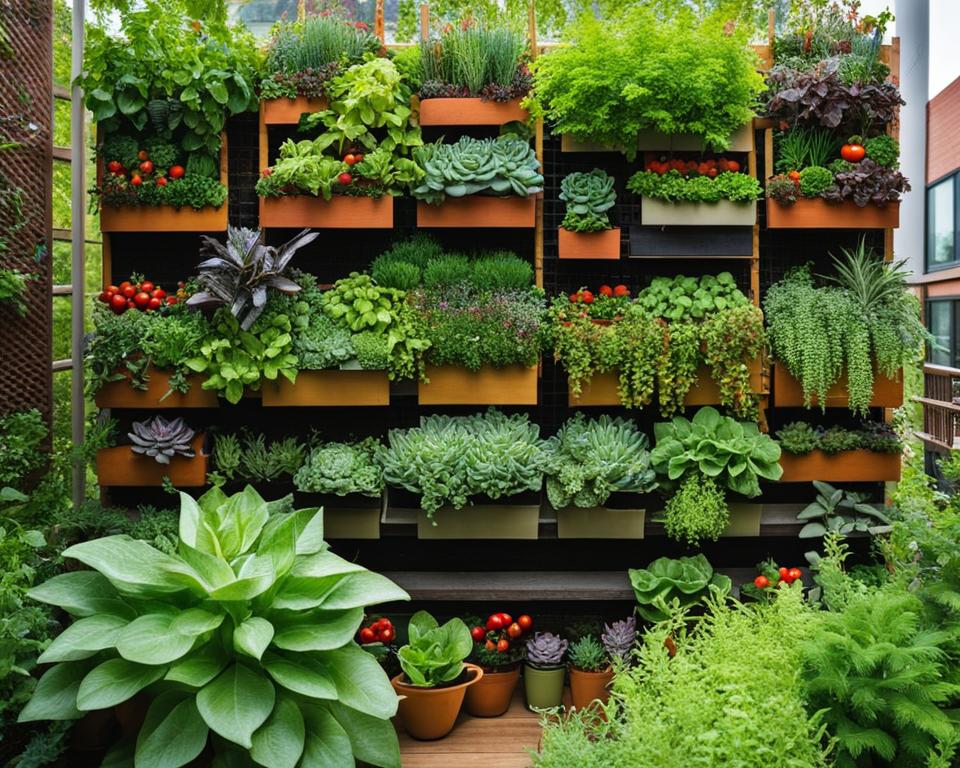
Innovative ideas for vertical structures in your gardening space hold the key to making the most of small urban areas. Let’s explore a few creative designs for vertical garden structures that can enhance your vegetable growing efforts and help you reap the benefits of vertical gardening.
1. Stacked Pots
A delightful combination of aesthetics and functionality, stacked pots are a popular option for creative vertical vegetable gardening. Using a vertical metal or wooden rod, you can either purchase specially designed stacking pots or simply drill drainage holes in the bottom of regular pots. Create your own unique pattern for stacking, and maximize space while adding a touch of beauty to your garden.
2. Spiral Gardens
For an elegant touch, spiral gardens are a perfect choice. Constructed with stones or bricks, these spiraling columns provide a suitable environment for vining vegetables like tomatoes and cucumbers, while also serving as a focal point in your outdoor space.
3. Vertical Wire Grids
A wire grid is a practical option for those who prefer a low-cost, minimalistic approach. Easily attach a wire grid to a wall or fence, and use it to support climbing plants. This vertical garden structure provides ample opportunity for maximizing space and organizing plants efficiently.
4. Hanging Gardens
Utilize the vertical space created by hanging containers from a wall or ceiling. This approach works especially well for herbs and compact leafy greens, adding an enchanting touch to your garden while maximizing space.
“The best way to maximize space in a small area is by growing vertically – this will create more energy-efficient gardens and cityscapes.”
– Patrick Blanc, Vertical Garden Expert
Now that we’ve provided a few vertical garden structure ideas, let’s compare them in a table to help you make an informed decision for your own creative vertical vegetable garden:
| Vertical Structure Idea | Benefits | Drawbacks |
|---|---|---|
| Stacked Pots | Attractive design, easy to customize, excellent for small spaces. | Potential cost of stacking pots, drainage issues if not planned well. |
| Spiral Garden | Stunning focal point, suitable for climbing plants, durable structure. | Can take up more horizontal space, may require professional assistance for construction. |
| Vertical Wire Grids | Affordable, minimalistic, efficient use of space. | Less visually appealing than other options, may not accommodate larger plants. |
| Hanging Gardens | Space-saving solution, enchanting appearance, ideal for herbs and leafy greens. | Additional support required if using heavy containers, not suitable for large and heavy vegetable plants. |
Remember, the most effective vertical garden structure will depend on your specific needs, space, and personal preferences. The key is to think creatively and be open to experimenting in order to find the best solution for maximizing your gardening potential.
Vertical Gardening Techniques for Urban Agriculturists
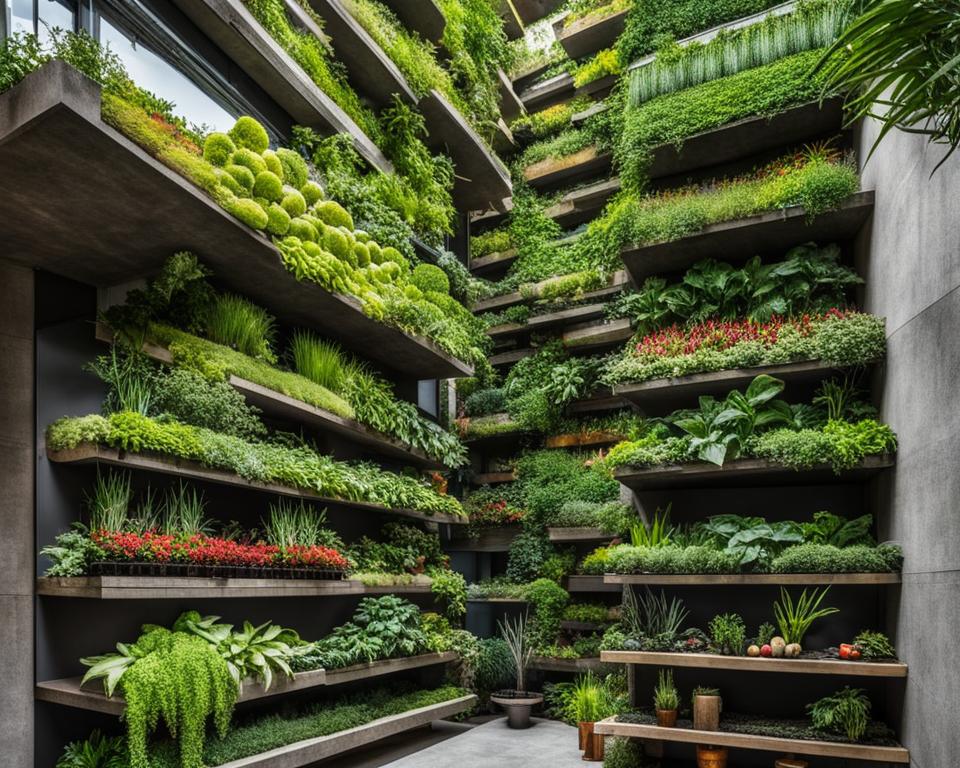
Urban agriculturists looking for innovative ways to grow food in limited space will benefit from incorporating various vertical gardening techniques into their home gardens. This section will explore two popular and effective techniques: utilizing trellises and climbing frames, and implementing hanging baskets and wall planters.
Utilizing Trellises and Climbing Frames
Trellises and climbing frames are excellent choices for vertical vegetable garden designs in urban settings. They make efficient use of vertical space, allowing plants to grow upward instead of spreading horizontally. Some common vegetables that thrive on trellises include peas, beans, cucumbers, and tomatoes.
Tip: To create a more attractive vertical garden, choose trellises and climbing frames with interesting and visually pleasing designs. This can turn your garden into a green, beautiful, and functional work of art.
Before installing a trellis or climbing frame, consider the following factors to ensure your chosen structure is the most suitable for your garden:
- Size: Pick a structure that is appropriate for the space available in your garden and the expected size of the plants you select.
- Material: Choose a durable material, such as wood or metal, that can withstand the weight of mature plants and resist the elements.
- Mobility: Consider whether you need a mobile structure that can be moved or disassembled easily to accommodate changing sunlight patterns or garden layouts.
Implementing Hanging Baskets and Wall Planters
Another effective and visually appealing vertical gardening technique is using hanging baskets and wall planters. These space-saving solutions work well in areas with limited ground space, such as balconies or along exterior walls. Suitable vegetables for hanging and wall planters include lettuce, spinach, Swiss chard, and small herb varieties.
When choosing hanging baskets and wall planters, pay attention to the following factors:
- Weight capacity: Ensure your selected hanging baskets or planters can safely hold the weight of the plants and soil when fully saturated with water.
- Drainage: Opt for containers with adequate drainage to prevent root rot and maintain a healthy growing environment for your plants.
- Weather resistance: Select materials that can withstand outdoor weather conditions throughout the year.
In conclusion, cultivating a thriving vertical vegetable garden in an urban setting requires creative thinking and the implementation of effective vertical gardening techniques. By utilizing trellises, climbing frames, hanging baskets, and wall planters, urban agriculturists can turn small spaces into productive, green, and attractive environments.
Different Types of Vertical Vegetable Garden Designs
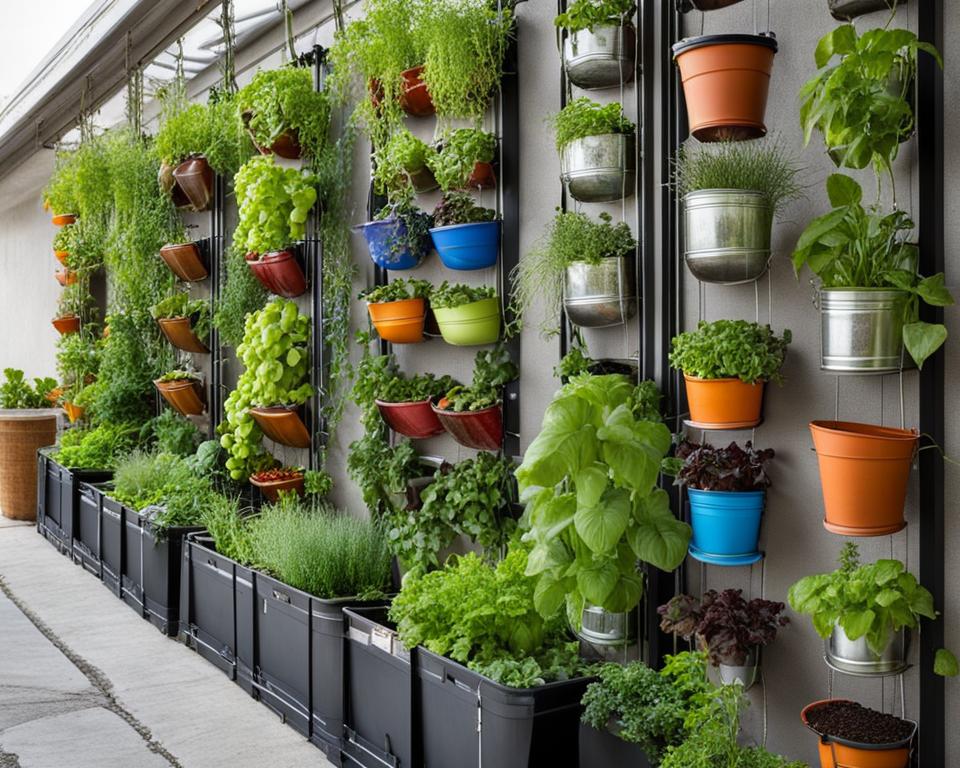
Designing your vertical vegetable garden goes beyond practicality; it is also an opportunity to express your creativity and personal style. There are various vertical garden designs to choose from, catering to different skill levels, budgets, and aesthetic preferences. In this section, we will explore an array of design ideas, from simple DIY options to more sophisticated systems, illustrating how different designs can fit into various urban spaces while maintaining functionality.
“The only limit to your vertical vegetable garden design is your imagination.”
Here are some popular and creative vertical vegetable gardening ideas:
- Living Wall: A living wall, also known as a green wall or vertical garden, consists of plants attached directly to a wall or mounted on a panel. This design is perfect for creating a beautiful, outdoor focal point or adding some greenery to your indoor living space.
- Trellises and Climbing Frames: Trellises and climbing frames are ideal support structures for vining plants, such as beans, peas, and tomatoes. They come in various materials, including wood and metal, and can be free-standing or attached to a wall. This design offers a versatile and space-saving solution.
- Vertical Tower Garden: A vertical tower garden is an upright, cylindrical container filled with growing media, typically soil or a soilless mix. It can accommodate several tiers of plants and is perfect for growing smaller vegetables such as lettuce and herbs.
- Pallet Garden: Repurposing wooden pallets is an affordable and sustainable option for creating a vertical garden. You can simply lean the pallet against a wall or secure it to a fence, then fill the slats with soil and plant your vegetables. This design is an excellent choice for those keen on DIY projects.
- Stacked Containers: Arranging multiple containers, such as window boxes or pots, in a vertical arrangement is a straightforward and adaptable design. You can use shelves, ladder-like structures, or other support systems to place containers at different heights, maximizing your vertical space.
Selecting the right design depends on your available space, budget, and desired aesthetic. To help you make an informed decision, here’s a comparative table of the characteristics and suitability of the aforementioned design ideas:
| Vertical Garden Design | Estimated Cost | Skill Level Required | Space Requirements |
|---|---|---|---|
| Living Wall | $$$ | Intermediate | Large wall space |
| Trellises and Climbing Frames | $$ | Beginner to Intermediate | Moderate ground space |
| Vertical Tower Garden | $$ – $$$ | Beginner to Intermediate | Small ground space |
| Pallet Garden | $ | Beginner | Moderate ground space |
| Stacked Containers | $ – $$ | Beginner | Variable ground space |
Embrace your creativity, and don’t be afraid to customize your vertical vegetable garden design to suit your unique taste and needs. With some imagination and planning, you can transform any urban space into a thriving, green haven.
DIY Vertical Gardening Projects You Can Start Today
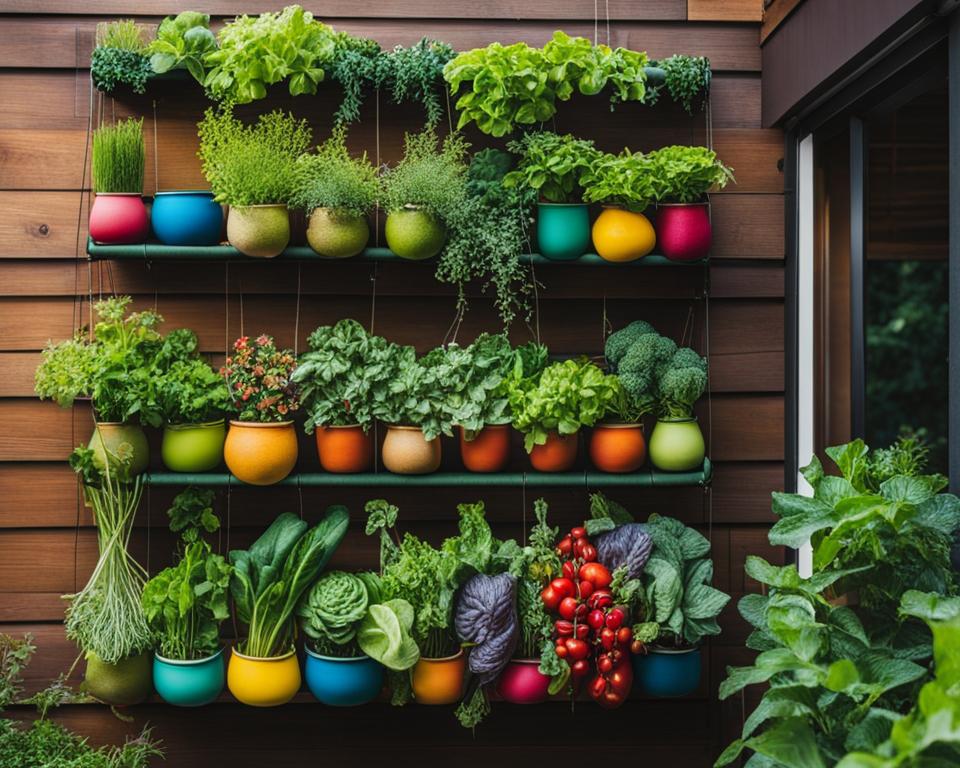
Ready to embark on your urban gardening adventure? Here are two DIY vertical gardening projects perfect for small spaces, which you can start today. Both are easy to set up and maintain, making them perfect for those who are new to vertical vegetable gardening.
Building a Pallet Garden
A pallet garden is an excellent way to repurpose wooden pallets into functional and attractive vertical vegetable gardens. Follow these step-by-step instructions to create your own urban oasis:
- Obtain a treated, heat-treated, or untreated wooden pallet in good condition.
- Check for any protruding nails or splinters and sand the surfaces if necessary.
- Attach landscape fabric to the back, sides, and bottom of the pallet using a staple gun to create a secure planting pocket.
- Fill the pocket with a potting mix suitable for vegetables, making sure to pack it firmly.
- Lay the pallet flat and add your seedlings or transplants, ensuring they are securely placed in the planting pocket.
- Water the pallet thoroughly and let it remain horizontal for a couple of weeks, allowing the plants to take root.
- Erect the pallet vertically against a sturdy wall, fence, or support structure, and secure it in place.
- Keep the pallet garden well-watered and enjoy the fruits (or veggies) of your labor!
You now have a beautiful, space-saving vertical vegetable garden that adds charm and character to your urban space. Don’t forget to share your completed pallet garden with friends and fellow urban gardeners for inspiration!
Creating a Vertical Tower Garden
Vertical tower gardens are another great way to cultivate a variety of vegetables within a small urban space. They are simple to create and allow for space-saving stacking as your plants grow. Here’s how:
- Purchase or repurpose several large containers for your vertical tower base. Ensure they have adequate drainage holes.
- Fill the containers with potting mix suitable for vegetables.
- Choose vegetables that are well-suited for vertical growing, such as pole beans, tomatoes, cucumbers, or peas.
- Plant the vegetables around the edges of the containers, positioned to maximize vertical growth.
- Install a trellis, cage, or garden netting to encourage upward growth of your plants.
- Water and fertilize your tower garden regularly as needed, depending on the specific vegetables you’ve chosen.
- Harvest your vegetables when they are ripe and enjoy your fresh, homegrown produce!
Vertical tower gardens are an efficient and visually appealing way to enhance your urban space while providing a plentiful harvest. Don’t hesitate to get creative with your tower garden design and experiment with different combinations of vegetables.
With these two DIY vertical gardening ideas, you’re well on your way to creating a thriving vertical vegetable garden in your small urban space. You can now enjoy fresh, homegrown produce while contributing to the urban greening movement. Don’t forget to share your vertical gardening projects with friends and fellow garden enthusiasts to inspire their own urban agriculture ventures!
Materials and Tools Necessary for Vertical Vegetable Gardening
Creating and maintaining a vertical vegetable garden in an urban setting requires a selection of essential materials and tools. While some of these may already be available in your home, others might need to be purchased. In this section, we will cover the urban vertical gardening essentials you’ll need to start and sustain your garden.
Building a successful vertical vegetable garden requires an investment in both time and materials. It’s crucial to have the right tools at your disposal for a seamless gardening experience.
Here are the must-have materials and tools for vertical gardening:
- Vertical Garden Structures: Depending on your choice of design, gather the necessary materials to build the structure. This may include trellises, climbing frames, hanging baskets, or wall planters.
- Plant Containers: Specially designed containers for vertical gardens, such as fabric pockets or stackable pots, are essential for maximizing space while promoting healthy plant growth.
- Organic Soil Mix: A high-quality, nutrient-rich soil mix tailored for vegetable growth is vital for the success of your garden.
- Fertilizers and Nutrients: Organic fertilizer and micronutrients help enhance plant growth and ensure a bountiful harvest.
- Watering System: A suitable watering system, such as drip irrigation, will help maintain optimal moisture levels in your vertical garden.
Essential tools for vegetable gardening include:
- Gardening Gloves: Investing in a durable, comfortable pair of gloves is a wise decision for any gardener, as it helps protect your hands while working.
- Pruners: A reliable set of pruners come in handy for maintaining plant health and controlling growth.
- Trowel and Cultivator: These tools assist in tasks such as digging, planting, and loosening soil around your plants.
- Garden Scissors: Useful for precision tasks like trimming leaves and harvesting vegetables.
- Handheld Sprayer: A spray bottle facilitates fertilizing and pest management in your vertical garden.
| Materials | Tools |
|---|---|
| Vertical Garden Structures | Gardening Gloves |
| Plant Containers | Pruners |
| Organic Soil Mix | Trowel and Cultivator |
| Fertilizers and Nutrients | Garden Scissors |
| Watering System | Handheld Sprayer |
By investing in the right materials and tools for vegetable gardening, you set yourself up for success in your urban vertical gardening journey. Always prioritize quality to ensure a healthy and beautiful garden capable of producing a bountiful harvest season after season.
Watering Solutions for Vertical Vegetable Gardens
Maintaining a healthy and thriving vertical vegetable garden requires a keen understanding of its unique watering needs. This section will provide an overview of different watering solutions and their pros and cons to help you make the best choice for your garden.
One of the key factors to consider when selecting a watering solution is its efficiency. Efficient watering not only saves water but also ensures that your plants receive just the right amount of moisture without over or under-watering.
Drip Irrigation Systems for Efficient Watering
Drip irrigation systems are an excellent choice for urban gardeners seeking efficient watering solutions. They deliver water directly to the root zone of your vegetables, minimizing evaporation and wastage. This method also helps to maintain consistent soil moisture levels, crucial for the health of your vertical garden.
Installing a drip irrigation system in your vertical garden is a relatively straightforward process. You can choose from pre-assembled kits or create a customized setup using components available at your local garden supply store. To set up your own system, follow these general steps:
- Measure and plan the layout of your irrigation system, taking into account the size and structure of your vertical garden.
- Install a water timer to regulate the watering frequency and duration.
- Attach a pressure regulator and filter to your garden hose or water source.
- Position the mainline tubing to run along the top of your vertical garden and secure it in place.
- Attach drip emitters or micro-sprayers at intervals along the tubing to target plant roots directly.
- Connect the tubing to the water source and the timer.
- Test the system and adjust the drip emitters as needed to ensure adequate watering coverage.
While the initial investment for a drip irrigation system may be higher than other watering methods, the long-term benefits are well worth it, particularly for urban gardeners looking to maximize the productivity and longevity of their vertical gardens.
Ultimately, the success of your vertical vegetable garden depends on the combination of practical design, adequate sunlight, nutrient-rich soil, and efficient watering solutions tailored to your unique urban space. By applying these vertical gardening tips and carefully considering your watering options, you can create the flourishing garden of your dreams even in the most compact city environment.
Caring for Your Vertical Vegetable Garden: Maintenance Tips
Maintaining a healthy and thriving vertical vegetable garden requires consistent care and attention. With the right maintenance tips and vertical gardening techniques, you can ensure the long-term success of your urban garden. In this section, we’ll provide you with practical tips on pest management, nutrient supplementation, and pruning advice for your vertical garden.
- Pest Management: Keep your garden free from pests by regularly checking plants for signs of infestations. Introduce natural predators such as ladybugs and lacewings to combat invasive insects or use organic, eco-friendly pesticides as needed. Keep the garden clean by removing dead leaves and debris that can provide hiding spots for pests.
- Nutrient Supplementation: Vertical gardens may require additional nutrients since the soil in containers or wall planters can be relatively shallow. Use organic compost and slow-release fertilizers to provide adequate nutrition for your plants. Regularly monitor the pH levels of your soil and adjust as needed with natural amendments.
- Pruning and Training: Proper pruning encourages healthy growth and prevents overcrowding in a vertical garden. Prune plants regularly to remove dead or damaged foliage and promote air circulation. Train climbing plants early by gently guiding them onto their supports to encourage upward growth and proper form.
Moreover, a well-maintained vertical garden also depends on efficient watering and proper sunlight exposure. Remember to water your plants according to their individual needs and ensure that they receive adequate sunlight for optimal growth.
“A well-maintained vertical garden is not only productive but also visually appealing, contributing to a greener urban environment.”
In conclusion, caring for your vertical vegetable garden involves staying vigilant about potential issues, addressing them promptly, and providing proper care to ensure its continued success. Happy gardening!
Enhancing Urban Biodiversity with Vertical Gardens
Vertical gardens not only offer creative solutions for growing vegetables in urban spaces, but they also play a crucial role in enhancing urban biodiversity and promoting sustainable urban living. By incorporating vertical gardens into cityscapes, urban dwellers can contribute to improving air quality, supporting pollinators, and creating a healthier urban ecosystem.
One of the most significant vertical gardening benefits is the support they provide for pollinators, such as bees, butterflies, and hummingbirds. In recent years, these vital creatures have experienced a decline in population, largely due to habitat loss and the widespread use of pesticides. Vertical gardens, especially those that include a mix of flowers and vegetables, help to create a welcoming environment for pollinators, ultimately improving urban biodiversity and the overall health of the ecosystem.
Another positive impact of vertical gardens is their potential to improve air quality. The plants in vertical gardens can absorb air pollutants, acting as natural air purifiers. In busy, congested cities with limited green spaces, vertical gardens can help alleviate some of the pollution caused by vehicles and industrial sources.
“Vertical gardens offer an innovative solution for enhancing urban biodiversity while providing fresh and healthy food to people living in cities.”
Additionally, incorporating vertical gardens into urban environments can help combat the urban heat island effect, an issue that causes temperatures in cities to be significantly higher than those in surrounding rural areas. By adding green spaces, such as vertical gardens, temperatures can be reduced through the natural process of evapotranspiration, and the urban environment becomes more resilient to climate change.
Here are some tips for enhancing urban biodiversity with your vertical garden:
- Plant a variety of vegetables and flowers to attract different pollinators and support a diverse range of species.
- Choose native plants that are adapted to your local environment and can support local wildlife.
- Reduce or eliminate the use of chemical pesticides and fertilizers, opting for organic alternatives instead.
- Include a water source, such as a small birdbath or shallow dish, to provide water for pollinators and other wildlife.
In conclusion, vertical gardens not only offer a practical solution to small-space vegetable gardening but contribute significantly to urban biodiversity and sustainable living. By incorporating vertical gardens into our cities, we can create a greener, healthier, and more resilient urban ecosystem.
Conclusion
As urban dwellers search for sustainable and convenient ways to grow their own vegetables, vertical gardening proves to be an increasingly popular choice. Throughout this article, we’ve explored numerous vertical vegetable gardening ideas, designs, and techniques that can be applied to small urban spaces, ultimately leading to vertical vegetable gardening success.
Vertical gardens not only contribute to urban biodiversity but also help improve air quality and support pollinators. By embracing the urban greening movement, you can transform your city living space into a greener, more sustainable environment. Furthermore, getting involved with the vertical gardening community grants you the opportunity to learn from others, exchange ideas and experiences while inspiring one another to enhance urban living conditions.
In conclusion, make the most of your limited space by incorporating vertical vegetable gardens. No matter your skill level or the size of your space, the possibilities are endless when it comes to creating a thriving, productive, and visually appealing vertical garden. So why wait? Join the urban greening movement today and start reaping the rewards of your very own vertical vegetable garden.
FAQ
What is vertical vegetable gardening?
Vertical vegetable gardening is a method of growing plants in an upward direction, using various structures like walls, trellises, and towers to maximize space in limited areas. This innovative gardening approach is especially useful in urban spaces where horizontal space is at a premium.
How can vertical gardening be helpful for city dwellers?
Vertical gardening provides an opportunity for city dwellers to grow fresh produce in their limited outdoor spaces, turning balconies, rooftops, and even small yards into green, productive oases. Urban vertical gardens can improve air quality, support biodiversity, and act as a sustainable and environmentally-friendly way to grow food close to home.
What types of vegetables can I grow in my vertical garden?
There’s a wide variety of vegetables and herbs suitable for vertical gardens. Leafy greens like spinach, kale, and Swiss chard work well, along with herbs such as basil, parsley, and mint. Dwarf varieties of tomatoes, peppers, and cucumbers are specifically bred for small spaces and make excellent choices for vertical gardens.
What structures can I use for my vertical vegetable garden?
There are numerous creative vertical structures available depending on your space and preferences. Some popular options include trellises, climbing frames, hanging baskets, wall planters, pallet gardens, and vertical tower gardens. Each structure provides unique benefits, so choose the one that best fits your needs and available space.
What tools and materials do I need to start a vertical vegetable garden?
While specific needs may vary depending on the chosen vertical structure, essential items generally include seedlings or seeds, potting soil, containers or planting media, a watering system (like a drip irrigation system), and basic gardening tools like pruners, trowels, and gloves.
How can I efficiently water my vertical vegetable garden?
Drip irrigation systems are a popular solution for efficient watering in vertical gardens. These systems deliver water directly to the base of each plant, conserving water and preventing moisture-related issues like mold and mildew. Other watering solutions include self-watering containers and manual methods, such as using a watering can.
What is the role of vertical gardens in enhancing urban biodiversity?
Vertical gardens contribute to urban biodiversity by providing green spaces and supporting pollinators like bees and butterflies. They can also improve air quality and help create a healthier urban ecosystem. By growing a variety of plants and providing habitats for insects and birds, vertical gardens can significantly enhance the biodiversity in urban areas.

